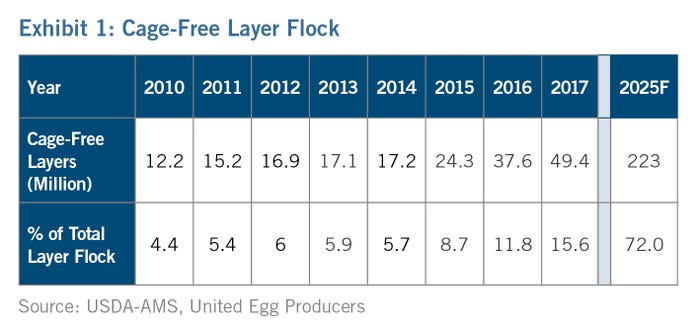Output expected to mirror demand as producers cautiously invest in cage-free eggs.

Food company commitments recently pushed cage-free egg production to new heights, but U.S. egg markets are returning to more normal production growth, producer profitability and specialty egg premiums, according to a new report from CoBank’s Knowledge Exchange Division.
“The avian flu outbreak in 2015 caused egg prices to climb and incentivized egg producers to boost output. Coincidentally, 229 major food companies pledged to use cage-free eggs by 2025 just as egg prices went into freefall,” CoBank animal protein economist Trevor Amen said. “Since then, cage-free production has surged amidst a surplus of inexpensive, conventionally produced eggs.”
This oversupply has depressed demand for higher-priced cage-free eggs -- a condition that Amen said is expected to last for the next several months as the conventional supply is drawn down.
CoBank noted that the historical average for the premium on cage-free eggs is 120%, but during the egg supply shortage, the premium fell to zero. Once the conventional egg supply ballooned, the premium peaked at more than 250%. In 2017, the premium has fallen and is expected to trend toward normalization in 2018, the report suggested.
Meanwhile, total table egg production is expected to return to historical growth patterns as low egg prices encourage producers to pare back production and profitability returns to normal levels.
“This will allow the price premium for cage-free eggs to recover to historical averages and help facilitate the transition in the coming years as a reduction in cage-free egg production brings supply into alignment with true demand,” Amen said.
Cautious conversion
To fully meet food company pledges to market all or a significant portion of their eggs as cage-free, the CoBank report said about 223 million layers, or nearly three-quarters of the entire U.S. layer flock, would need to meet the cage-free criteria. Currently, only 16% of the layer flock is estimated to be classified as cage-free, which is still up from 4% in 2010.

It will cost the industry about $10 billion to fully make the transition to meet the cage-free pledges, with most of that expense coming in the form of remodeling existing layer houses or constructing new facilities. However, the current overabundance of conventional eggs makes this investment difficult in the near term, the report pointed out.
In 2016 and 2017, producers with cost-plus arrangements and fixed-price contracts were able to capture the premium on cage-free eggs, but all other producers -- with exposure to the spot market and decreased demand for cage-free eggs -- had to sell their supplies in the conventional markets, ultimately hurting their margins, the report said.
“Less expensive, abundant supplies of conventionally produced eggs and the memory of negative margins in 2016 have made producers hesitant to make investment to transition to high-cost cage-free eggs,” CoBank said.
The egg market is expected to strengthen, providing an economic incentive to respond to market forces. Additionally, robust egg exports are helping to reduce domestic egg supplies and are anticipated to support wholesale values in 2018. Total U.S. egg exports increased 32% year over year in September and show no sign of slowing, the report said.
Despite anticipated market improvements, CoBank said the “lofty goal” of 2025 for the cage-free supply is unlikely.
Nonetheless, the rebalancing of the market will allow the cage-free transition to be driven by fundamental consumer demand rather than pledges made by retailers and food manufacturers, Amen said.
“As a result, large egg producers are taking a more cautious approach to cage-free expansion by focusing on long-term growth potential and market premium expectations,” Amen said. Some of the largest egg producers indicated this year that they are reducing their cage-free production while the market tries to find equilibrium.
“Output is unlikely to follow the growth trajectory needed to meet the stated commitments by 2025 and instead will mirror actual end user demand,” the report concluded.
About the Author(s)
You May Also Like


.png?width=300&auto=webp&quality=80&disable=upscale)
